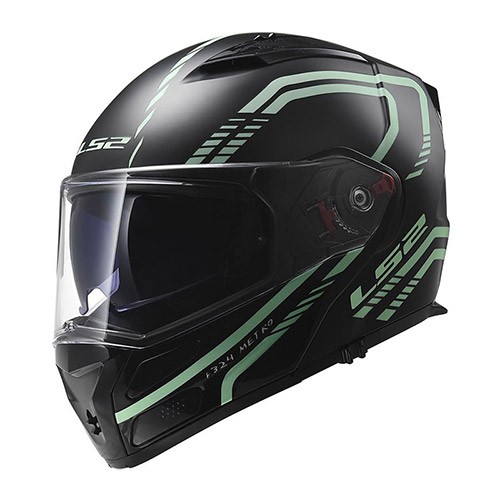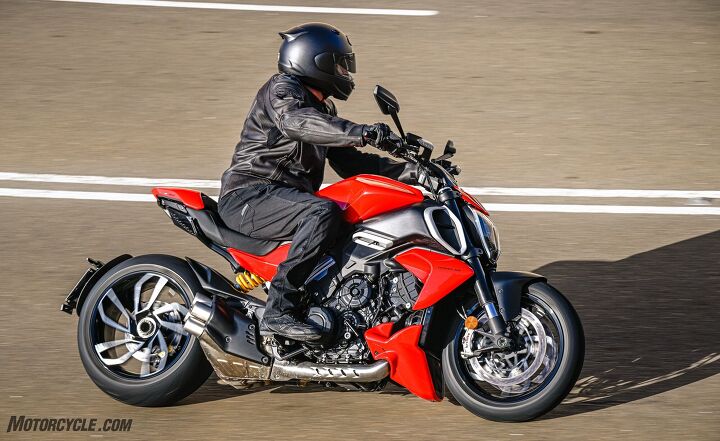
The problem with the Ducati Diavel has always been the inability to adequately describe the type of motorcycle it was. Power Cruiser never came close to encompassing the bike’s capabilities. Similarly, Muscle Bike implied the brute force it’s capable of quite well but overlooked the finesse with which it could be applied. With the addition of the V4 Granturismo engine, the Diavel has matured into the bike it was always meant to be, the Mega-Monster. The 2023 Ducati Diavel V4 has reached the point in its design and performance in a way that leaves all vestiges of cruiserness in its dust.
2011 Ducati Diavel Review
2019 Ducati Diavel 1260S Review – First Ride
The Ducati Diavel has been around long enough that I shouldn’t be shocked by its performance capabilities, but I still am every time I throw a leg over one. This time, it adds the V4 Granturismo engine to the already impressive package.
Editor Score: 91.5%
| Engine | 19.5/20 | Suspension | 14/15 | Transmission | 9.25/10 |
| Brakes | 9.25/10 | Instruments | 4.5/5 | Ergonomics | 8.5/10 |
| Appearance | 9/10 | Desirability | 9/10 | Value | 8.5/10 |
+ Highs
|
– Sighs
|
In order to see where the Diavel V4 is, it’s important to look back at where it’s been. First introduced in 2011, the Diavel has been through two generations, the Diavel and, in 2019, the Diavel 1260. Over that time, it has sold more than 45,000 units worldwide. For a motorcycle that doesn’t fit cleanly into any established category, this is an impressive number. Now, for 2023, Ducati has unleashed the third evolution of the Diavel, the Diavel V4, and it’s a beast.

The 2023 Ducati Diavel V4, a closed road, and a full moon.
To pound the changes in the Diavel V4 home, Ducati gathered the world press on the top of the only mountain in the emirate of Abu Dhabi. The road that climbs Jebel Hafeet is famous worldwide for its 60 turns in just 6.64 miles. Constructed in 1980 for sheiks to enjoy their super car playthings, the road delivers almost perfect pavement and a few extended straights to put the V4 through its paces. In many ways, having access to a closed road where anything goes, is an ideal way to test a street bike that truly has no track aspirations. Unlike a track introduction, where riders are tempted to push the bike and their personal limits, riding on the street – even on a closed highway – requires that you keep reasonable reserve in your pocket. However, this is the only place we rode the bike, making it impossible for me to comment on street-focused concerns, like around-town or highway manners. So, we’ll need to test a Diavel V4 Stateside to experience real-world use. (And I’ve already put in a request.)
V4 Granturismo engine
The biggest change in the Diavel V4 is the doubling of cylinders while losing a whopping 11 lbs. Since the V4 mill is the latest iteration of the Granturismo engine first seen in the Multistrada V4 S last year, the Diavel also exchanges its desmodromic valve closure for springs – and a 37,000-mile valve maintenance interval. Compared to the Testastretta 1262 DVT V2 engine, the Granturismo also delivers a 3.3-in. shorter length and a 3.7-in. height. The width of the engine is only slightly wider, with a 0.8-in. delta. The quartet of 83 mm x 53.5 mm cylinders yields a 1158cc displacement (down from 1260cc in the Testastretta), but the claimed peak power delivery of 168 hp at 10,750 rpm is 11 hp more and 1,500 rpm higher than the previous generation Diavel’s claim. Claimed peak torque drops 2 lb-ft to 93 lb-ft at 7,500 rpm.
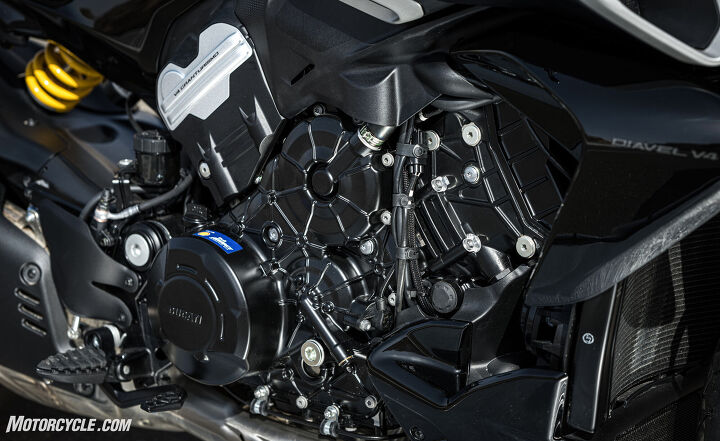
Since the Granturismo has been updated from last year’s Multistrada V4 S, you should also know that the cam shape and timing has been changed, along with the intake and exhaust systems plus the necessary EFI mapping required to achieve Euro 5 compliance. These changes were designed to broaden and flatten the torque curve. Additionally, the first gear was lowered for a more aggressive launch (made possible by Launch Control) for a claimed 3-second 0-60 mph time.
Though really under the umbrella of electronics, two other changes were made to the V4’s behavior. First, the extended rear cylinder deactivation system has made a profound change in how the engine behaves. Whereas the previous generation Granturismo only killed the rear cylinders at idle, the time has been extended. Not only do the rear cylinders cease firing at an idle at stop, in certain situations, they also shut off in motion. In gears 2-6 when the engine is below 4,000 rpm and the power requests from the throttle are low, the rear cylinders shut down. The transition is seamless, taking only milliseconds, with just the change in exhaust note as your signal. When running on two cylinders, the note is lower and increases in pitch when the Twin Pulse firing order resumes. Aside from reducing heat to the rider, Ducati claims that the fuel efficiency of the Diavel V4 is up by 6 %.
The other big electronic change that will affect every ride is the altering of the rules under which the up/down quickshifter allows shifts. Previously, downshifts were only allowed when the throttle was completely closed, but now, the system can account for having the throttle open. So, it allows downshifts when you are decelerating but have not completely closed the throttle.
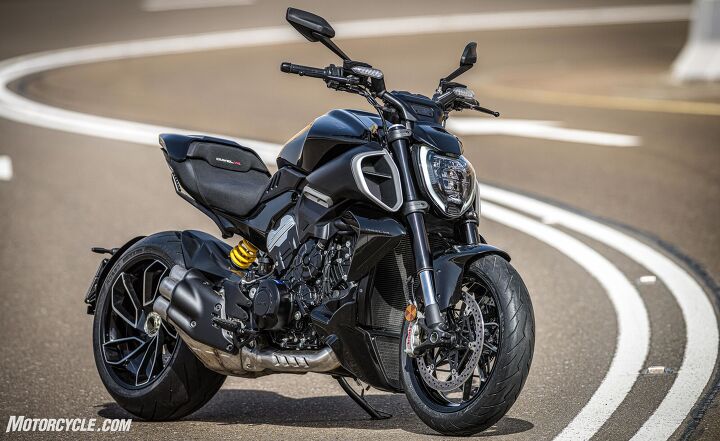
Nary a trellis in sight.
Chassis
As with the Monster, Ducati has excised the trellis frame from the Diavel, replacing it with a lightweight aluminum monocoque frame bolted to the cylinder heads. Traditionalists may bemoan the change, but a 10.4-lb reduction in weight is nothing to sneeze at and contributes to the total weight loss of 29 lbs (without fuel vs the Diavel 1260 S). Ducati’s designers were even able to get the front/rear weight bias to 51.3%/48.7%, respectively. Fans of trellis frames can take comfort in the subframe retaining that construction.
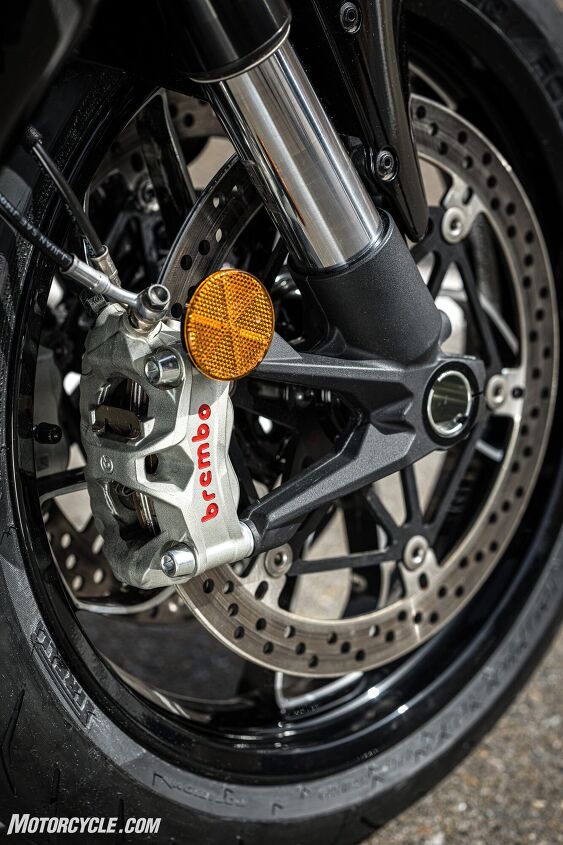
Brembo Stylemas and 330 mm discs mean you are stopping NOW!
The suspension is what you’d expect on a performance bike weighing 523 lb (claimed). The front is a 50-mm, fully adjustable unit, while the rear is a cantilever-pattern shock outfit with all the clickers. Rear wheel travel was bumped by 0.6 to 5.7 in. while the front stays at 4.7 in.
The 31.1-in seat height is 0.8 in. higher (though low- and high-seat options are available), and the grips are 0.8 in. closer to the rider. My initial impression of the “handlebar” (which is really two tubes mounted to an aluminum plate for weight savings) was that it could be a little closer still, where it would pay the most dividends in around-town riding (which, remember, we didn’t do). However, in full-on flog mode, where the rider is aggressively leaning in, the new location seems just about perfect.
With such an impressive engine in the chassis, you’d need some premium brakes to shed speed quickly, and Ducati didn’t disappoint. From the Brembo PR16/19 radial master cylinder to the radial, monobloc Stylemas, which all flow through updated cornering ABS algorithms, the hydraulic end of things is handled. The calipers mate to superbike-sized 330 mm floating discs to deliver eye-popping deceleration, which handily scrubbed from over 120 mph on one of the extended straights down for a second gear corner. But I’m getting ahead of myself.
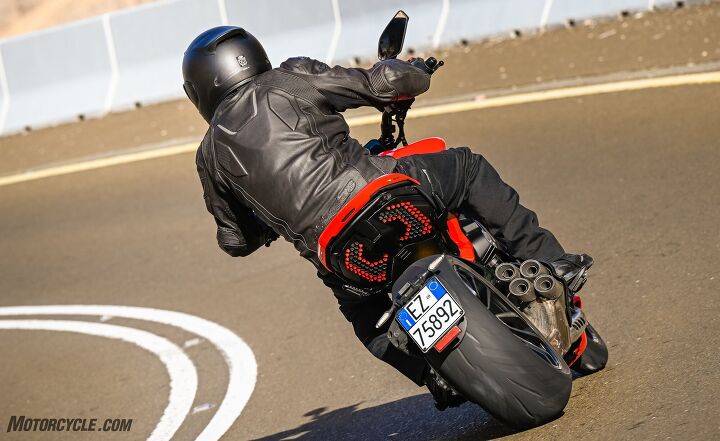
First, we need to address the wheels and tires. The wheels are five-spoke alloy items with polished machined highlights that one would expect from a premium motorcycle. The front carries the traditional-sized 120/70 ZR 17 rubber in the form of a Pirelli Diablo Rosso III. The rear tire is the signature piece of the Diavel, one highlighted by the exposure afforded by a single-sided swingarm. The 240/45 ZR17 Pirelli Diablo Rosso III is simply massive and, even after 12 years of Diavel production, looks like it will make the bike handle like a pig, but by now, we know how wrong that is.
Electronics
Front and center in the rider’s view from the saddle is a new 5.5-in. TFT display. As we’ve come to expect from Ducati, the menu system is easy to drill down through with the handlebar switch gear, allowing easy changes of riding modes. Aside from all of the important info about the motorcycle’s status, the screen now has the capability to display turn-by-turn directions via an accessory package. Without that, the standard Bluetooth connection allows for display of phone and music information.
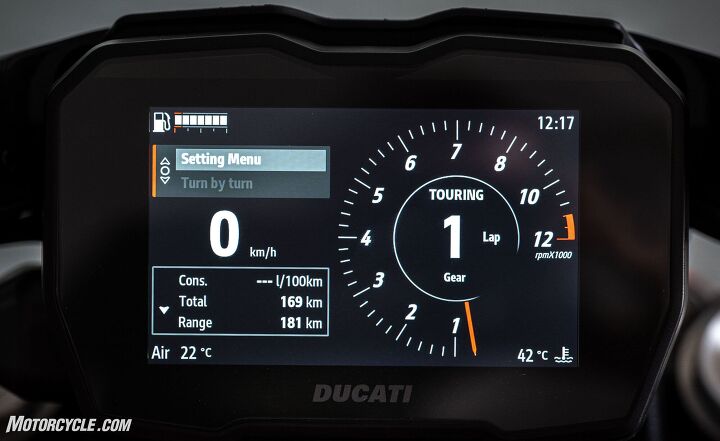
Four ride modes, Sport, Touring, Urban, and Wet, control three power modes (High, Medium, and Low). The power modes may be somewhat of a misnomer since both High and Medium modes deliver all the berries, though supposedly with a slightly different flavor. Low power cuts the power to 115 hp and is used in Urban and Wet modes. From the saddle in the very specific riding situation we were in, the difference between Sport and Touring were hard to suss out with my butt dynamometer. However, the fact that cornering ABS is disabled in Sport kept me in Touring mode for most of our mountain thrashes. If I made a mistake, I’m not too proud to ask for an assist – particularly with the concrete barriers that lined the road.
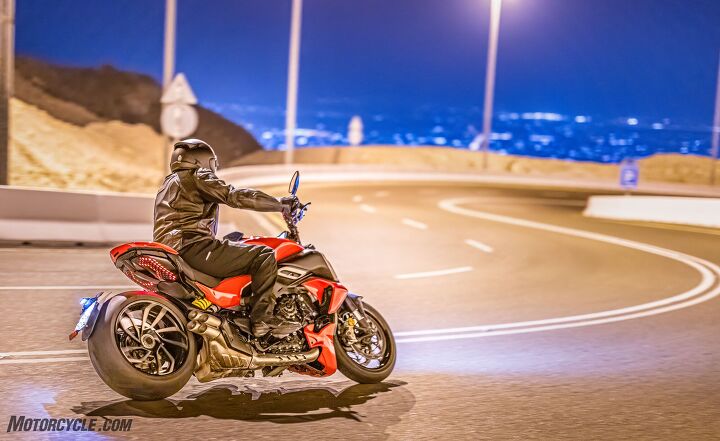
A private road (complete with police protection)
In my 27 years attending motorcycle introductions, I’ve never experienced one in which the manufacturer closed a public road and essentially said, “Have at it.” And yet, there I was at the base of Jebel Hafeet Mountain with 60 corners in 6.64 miles and 2,500 vertical feet gain ahead of me. The grade is around 7% average but is 11% at its steepest point. Of special interest to motorcyclists, however, is the lack of runoff along the concrete-barrier-lined roadway. As Ducati repeatedly reminded us, this is not a track.
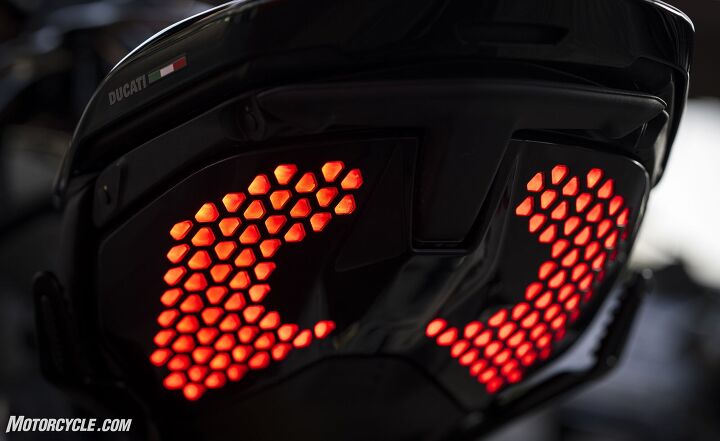
The V4 charges away from a start, thanks to the shorter first gear with the upshifts being delivered with typical Ducati quickshifter smoothness. Even with gravity working in my favor, the speed that the Diavel needed to scrub off for some of the ultra-slow corners required all of the braking power offered by the 330 mm discs, and though I never triggered the ABS, I felt that I approached it a couple of times and was glad to have that protection available to me.
While charging the corners after the few extended straights, the V4’s quickshifter proved again that Ducati has one of the best implementations of this technology around. Every time I ride a Diavel, it takes me a while to wrap my head around how it handles with that wide rear tire. Unlike other fat rear tired bikes I’ve experienced, the steering geometry doesn’t feel like it’s changing the further you lean it over. And then there’s the turn in effort. Given that the Diavel V4 is a 523-lb. motorcycle with a 240 mm rear tire, the steering is remarkably easy, even at high speeds. The 26° rake undoubtedly plays a role here, but the counter-rotating crankshaft also deserves credit for negating some of the rotational forces of the wheels. Consequently, I could easily set the desired lean angle or, as the corner required, open or tighten my line.
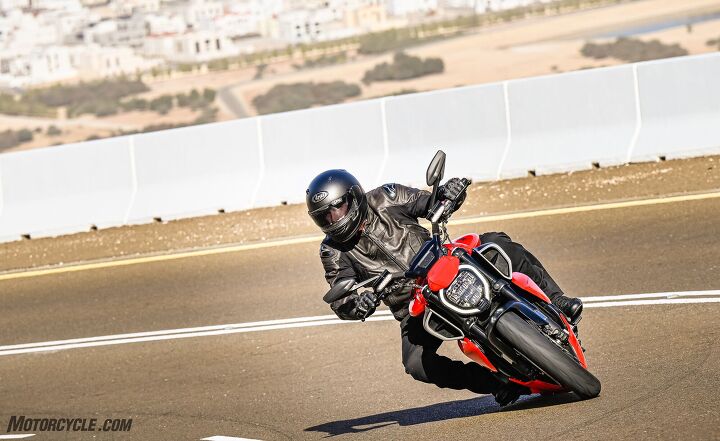
All it takes is a look at the Diavel V4’s riding position to know that the cornering performance will be limited by the peg placement. This is no track weapon, but it’s not a feet-forward cruiser, either. The ground clearance is quite respectable and almost what you’d expect from a naked bike of similar displacement. Almost, and the toes of my Alpinestars boots have the newly-beveled edges to prove it.
The suspension is also quite capable. Consider the side-to-side transitions and the nearly constant shifting from acceleration to braking and back again required by the 60 corners in such a short time, and you’ll have a pretty good idea of the forces the chassis was having to deal with. The results were a dead stable platform for attacking the mountain. Still, this ride, with its silky-smooth pavement, was hardly the real world. So, a full assessment of the suspension’s bump absorption capabilities will have to wait.
In the end, the Diavel V4 delivers a decidedly performance-oriented ride for riders with premium tastes and deep pockets. Unfortunately, having only a few chances to charge up a mountain road tells us little about what the Diavel is like to live with and log some real miles. The riding position feels comfortable enough to provide a good perch for tooling around town or attacking a series of corners. The power delivery is forceful enough to sate even the most power hungry while the braking and handling are capable of controlling that output.
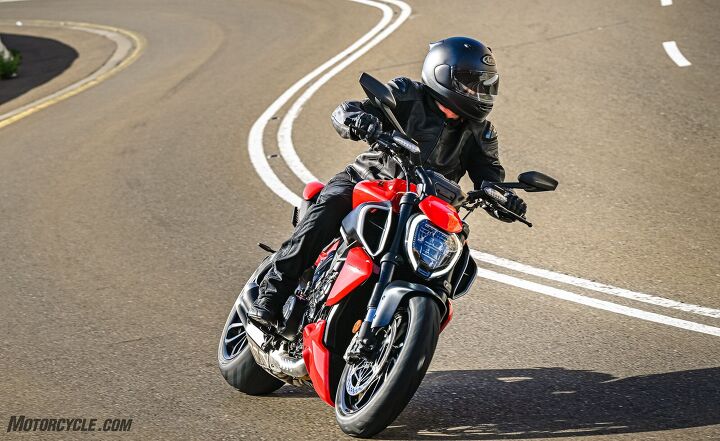
For me, the biggest puzzle about the 2023 Ducati Diavel V4 is how to categorize it. The cruiser connection was always strained, despite Ducati’s efforts. What are its natural competitors? The Triumph Rocket 3 at 642 lb? Puulease. The Harley-Davidson Sportster S? Not when there are corners around. The Kawasaki Z H2? Close (if we forget about the Streetfighter V4), but would anyone actually cross-shop it with the Diavel? So, perhaps the label of Mega-Monster fits, and we should be satisfied with placing the Diavel V4 in a class of one. Tell me your thoughts on what current motorcycle models compare to the Diavel V4.
Regardless of where my attempts to pigeonhole the Diavel V4 end up, it retains its status as a jaw-droppingly fun, in your face motorcycle, a motorcycle model that in its 12 years of production has, as I said at the top of this article, sold more than 45,000 units. For 2023 two versions are currently available (though an S version is likely in the future), and they vary by color. The Ducati Red Diavel V4 retails for $26,695, and the Thrilling Black bumps the price up to $26,995. If you think you may be of the Diavel persuasion, the V4 is the best one yet.
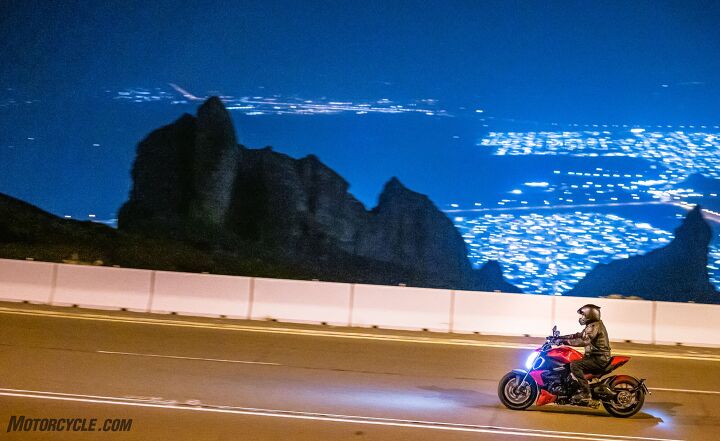
| 2023 Ducati Diavel V4 Specifications | |
|---|---|
| MSRP | $26,695 (red), $26,995 (black) |
| Engine Type | 1158 cc liquid-cooled Granturismo, V4 – 90°, 4 valves per cylinder, counter-rotating crankshaft, Twin Pulse firing order |
| Bore and Stroke | 83 mm x 53.5 mm |
| Compression Ratio | 14.0:1 |
| Horsepower | 168 hp @ 10,750 rpm (claimed) |
| Torque | 93 lb-ft @ 7,500 rpm (claimed) |
| Transmission | 6 speed with Ducati Quick Shift up/down |
| Final Drive | Chain |
| Front Suspension |
50 mm fully adjustable usd fork; 4.7-in travel |
| Rear Suspension |
Fully adjustable monoshock, aluminium single-sided swingarm; 5.7-in travel |
| Front Brake | Dual 330 mm semi-floating discs, radially mounted Brembo Stylema monobloc 4-piston callipers, radial master cylinder PR16/19, Cornering ABS |
| Rear Brake | 265 mm disc, Brembo 2-piston floating calliper, Cornering ABS |
| Front Tire | Pirelli Diablo Rosso III, 120/70 ZR17 |
| Rear Tire | Pirelli Diablo Rosso III, 240/45 ZR17 |
| Rake/Trail | 26 deg/4.4 in |
| Wheelbase | 62.7 in. |
| Seat Height | 31.1 in. |
| Curb Weight | 523 lbs. (claimed) |
| Fuel Capacity | 5.3 gal. |
| Colors |
Ducati Red, Thrilling Black |
| Warranty | 24 months, unlimited mileage |
We are committed to finding, researching, and recommending the best products. We earn commissions from purchases you make using the retail links in our product reviews. Learn more about how this works.
Become a Motorcycle.com insider. Get the latest motorcycle news first by subscribing to our newsletter here.
